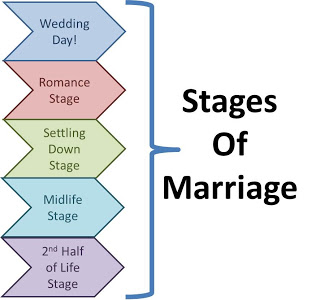When Bob and I got married 37 years ago, we expected to have one marriage that would last a lifetime. That hasn’t exactly happened. No, we’re not divorced. But the marriage we lived in our 20’s and 30’s no longer fits at midlife, after two children, career upheavals, and the ordinary joys and struggles of married life. In other words, we’ve had to create multiple marriages, all with the same person.
Social science research confirms our experience. It’s the nature of human beings to grow and develop—to change. As individuals change, so too does their marriage. The average marriage has somewhere between four and seven stages. At each stage, couples need to accomplish certain developmental tasks in order to move to the next stage. Movement from one stage to the next is precipitated by transitional events, such as the birth of a child, an empty nest, or the discovery of infidelity.
What does this mean for spiritual growth? A lot! The faith journey and the marital journey are inseparably bound. The marital journey provides the context in which the faith journey unfolds. It’s important, then, to understand something about the normal stages of marital growth.
Most marriages start in the Romance Stage, a time of joy, dreams and excitement. It’s a time of passion and promise. Unfortunately, couples can assume that this “mountain top” experience will last forever. They are disappointed, and sometimes unable to cope, when it ends.
The intensity of the Romance Stage inevitably gives way to the Settling Down stage, a time of the ordinary and routine. As children arrive, a major challenge is learning to take time for the marriage. Couples need to renegotiate financial, household and childrearing tasks. The marriage satisfaction rate can drop significantly.
The next stage is perhaps the most difficult. At midlife, spouses struggle to find individual self-fulfillment within a committed relationship. Struggles for power and control are common. The danger is that spouses will start to move away from each other. On the other hand, couples can achieve a closeness and emotional honesty that were not possible before.
The final stage of marriage, sometimes called the second half of marriage, is the newest and longest. This can be an exciting time for couples who have found a new sense of connection with each other. Separateness and togetherness are balanced. Hope returns, reminiscent of the first stage, but refined and matured.
Couples are challenged to grow in holiness as they live through these stages. A married person’s path to holiness goes directly through, not around, spouse and family. Holiness is not superimposed upon the couple, but arises from within the marriage. Couples often speak of becoming holy together.
One way to understand this faith journey is through the lens of Christ’s own suffering, death and resurrection—the Paschal Mystery. It’s the basic model for Christian living and, therefore, for married love.
Each marriage goes through its own version of the Paschal Mystery. There are Holy Thursdays, when couples are called to generous service, for example, in raising children, caring for aging parents, or volunteering in the community. There are Good Fridays, those times of inexplicable suffering—illness, job loss, infertility—when couples are called to embrace the cross and walk the path that Jesus did. There are Holy Saturdays, times of waiting, or uncertainty, or boredom, as spouses prepare for a new stage in life. And, thankfully, there are Easter Sundays, times of healing, reconciliation, and joy. Each step of the Paschal Mystery invites couples to deepen their union with God and with each other.
I’ve found it helpful to understand the stages of the marital journey as well as the faith journey. I’m reassured to know that my marriage is not necessarily falling apart if my husband and I don’t seem to be in synch with each other. It could simply be that we’re growing at different rates, one of us ready to try something new and the other aware of our limitations. I know, too, that suffering never has the last word, that death is always followed by new life. And I’m convinced that God is working in our marriage, through the highs and the lows, to bring us to our heavenly home.
——————–
 Sheila Garcia is the Secretariat of Laity, Marriage, Family Life
Sheila Garcia is the Secretariat of Laity, Marriage, Family Lifeand Youth, at the U.S. Conference of Catholic Bishops (USCCB) as well as the content editor for
the Bishops’ website, ForYourMarriage.org.

I always knew that our marriage was moving into different stages, and some are harder to deal with than others. Thank you for explaining it so well. We're somewhere between the midlife and 2nd Half stages I think after 11 years of Marriage. I most like the comparison with The Paschal Mystery. I've never thought of it that way. So beautiful. I am happy to share this article with my husband and friends!
Melissa, it *is* interesting, isn't it? For me, reading that there are stages – and that it's natural to progress through these stages – resonated and offered some reassurance that it was natural (and healthy) for things to change with time.
Thanks, Melissa! The comparison with the Paschal Mystery is not original with me, but I'm happy to use it since a lot of people find it helpful.